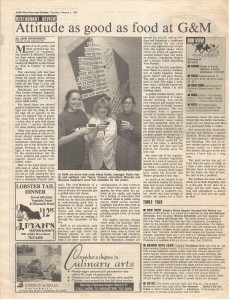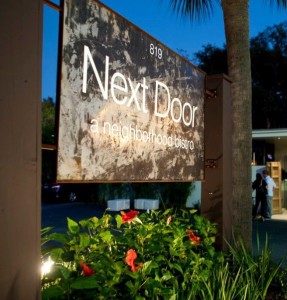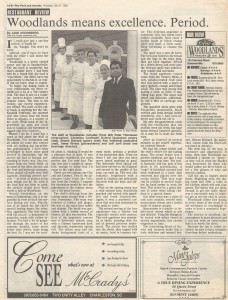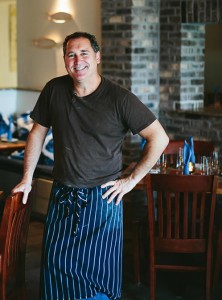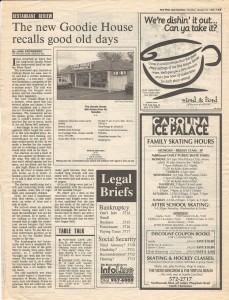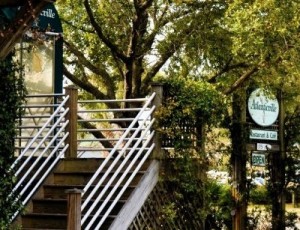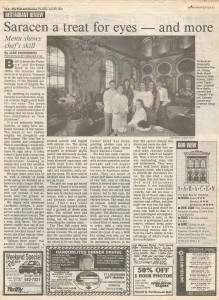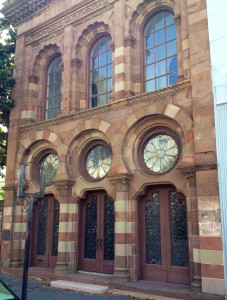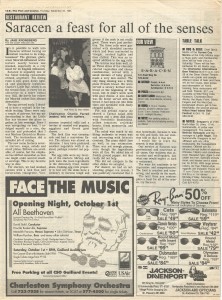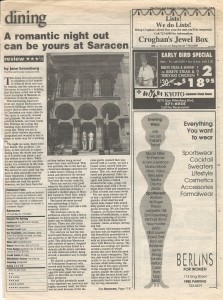Archives Flashback
Flashback Friday: Charleston Cuisine Ten Years Ago 3.27.15
 A staple every year is American Cuisine’s “Charleston Cuisine” menu book that features a variety of local chefs, along with a profile on their respected restaurant and their current menu. As a change for this week’s Flashback Friday, we look at the 2004 book cover. Ten years ago Charleston looked very different than it does today and we highlight some of those changes below:
A staple every year is American Cuisine’s “Charleston Cuisine” menu book that features a variety of local chefs, along with a profile on their respected restaurant and their current menu. As a change for this week’s Flashback Friday, we look at the 2004 book cover. Ten years ago Charleston looked very different than it does today and we highlight some of those changes below:
- John Zucker, Cru Cafe: Cru Cafe is a lowcountry institution and Chef Zucker has continued to offer great food in this charming single house. The restaurant celebrates its 15th year anniversary this year….cheers to that!
- Aaron Siegel: At the time of the photo, Aaron was executive chef at Blossom. In 2006, he left and opened Home Team BBQ in West Ashley and now has a location in Sullivan’s Island and will soon open a downtown spot.
- Craig Deihl, Cypress: Chef Deihl is still chef at Cypress and has gone on to open Artisan Meat Share future expanding his charcuterie offerings for the city.
- MariElena Dickson, Robert’s of Charleston: MariElena Raya, daughter of fame local chef Robert Dickson, has since married Joe Raya and together opened The Gin Joint where Robert’s was located. They also started Bittermilk, a company making and selling craft cocktail mixers.
- Marc Collins, Circa 1886: Ten years ago, Chef Collins was working hard on the original Planning Committee for the Charleston Wine + Food Festival and has been chef at Circa 1886 for over ten years. Circa 1886 just completed a restoration and continues to be a local favorite.
- Scott Crawford, Woodland’s: Woodland’s has since closed and Chef Crawford has moved to Raleigh where he is working on opening Standard Foods in a few months.
Who do you recognize from this photo?
We applaud those chefs who 10 years later are still a significant part of Charleston’s ever evolving culinary scene. Who will be around in another 10? We will have to wait and see.
FlashBack Fridays Review: Gaullart & Maliclet Café Restaurant 11.14.14
One of the longest running restaurants in Charleston is Gaullart & Maliclet Café Restaurant (G&M). Also known as Fast and French, the restaurant opened in the summer of 1984 in its current location at 98 Broad Street in the historic district of downtown Charleston, SC. Opened by Gwylene Gallimard and Jean-Marie Mauclet, the restaurant features a multi-generational team dedicated to providing “fresh, affordable, healthy, global cuisine with French flair in a social environment that encourages community, transparency and the Arts,” according to their website.
Gaullart & Maliclet this year celebrated 30 years in business—a milestone matched by few others. In the last 30 years, the restaurant has endured a myriad of challenges including Hurricane Hugo, the construction of the county courthouse, and nearly losing their building altogether, as discussed in this Charleston City Paper article from 2009.
The review we have is from Jane Kronsberg’s 1995 visit to G&M. Kronsberg spoke fondly of the quaint eatery noting its international cuisine and French focus. She wrote about it as a neighborhood mainstay offering a familiar and cozy place to grab a morning pick-me-up or afternoon nosh. The close quarters and old-fashion feel evoked a sense of community among its patrons, which ranged from locals working on Broad Street, tourists, and residents from the neighborhood.
She boasted about the dinner menu, the reasonable prices, top-notch service, and the Thursday night fondue—a special feature that remains a diner favorite today.
G&M has managed to maintain its foothold and cult-like following even as a recent influx of French cuisine has fallen upon the city. French restaurants in and around Charleston include: 39 Rue De Jean, Annie’s Bistro, Bistro Toulouse, Bougnat Restaurant, Brasserie Gigi, Chez Nous, Fat Hen, and Hege’s—and many of these opened just this year. With the pace of change in the restaurant industry in Charleston, it seems as though there will always be a “new kid on the block.” But sometimes what is needed most is to reconnect to industry elders like Gaullart & Maliclet.
FlashBack Fridays: The Colony House Review 10.31.14
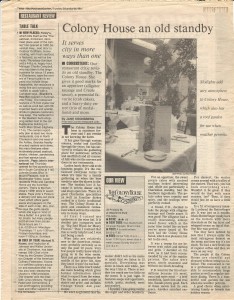 Review Date: Thursday, December 26, 1991
Review Date: Thursday, December 26, 1991
Located at 35 Prioleau Street at Waterfront Park, The Colony House was “an old standby,” with a lengthy history.
The Colony House was opened by the late Bill Snipes, who had previously opened The Sergeant and The Flag Room in the 1950s. Under his direction, the restaurant focused on beef, seafood, and traditional Southern dishes.
During the 1970s, Franz Meier, Chris Weihs, and Harry Waddington purchased The Colony House and shifted the focus to wine and international cuisine. The trio established The Wine Cellar, an addition to the main dining room that featured a French menu with a wine list that was exceptionally robust for the time.
After nearly 20 years, The Colony House was purchased by Dick Elliott of Maverick Southern Kitchens, who reopened the restaurant by hosting a fund-raising event for the Charleston Arts Council.
Jane Kronsberg visited the restaurant on more than one occasions. This review was written while under Elliott’s ownership. Kronsberg made note that the restaurant had been through a multitude of changes over the years, but it remained the dining room of choice for politicians and other important members of the community. Under new ownership, the menu once again featured traditional Lowcountry dishes, offering everything from soup and salad to seafood, beef, poultry, and pasta.
Kronsberg commented that The Colony House wine list was arranged according to suggested food pairings, which she surmised was designed to help American diners who were only recently introduced to sizable wine lists.
Three years after Kronsberg’s visit, The Colony House shuttered, bringing to a close a four-decade history of one of Charleston’s earliest fine dining establishments.
In 1994, The Harbor Club opened in its place.
Flashback Fridays: Two Decades at 819 Coleman Boulevard 10.17.14
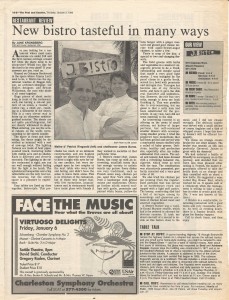 Several months have passed since the first signs of construction appeared at 819 Coleman Boulevard in Mount Pleasant. And since then, we’ve heard rumors, followed by several articles featuring renderings of the concept to come.
Several months have passed since the first signs of construction appeared at 819 Coleman Boulevard in Mount Pleasant. And since then, we’ve heard rumors, followed by several articles featuring renderings of the concept to come.
Earlier this week, Eater Charleston caught up with the man behind the new project, John Adamson of The Rarebit and Big John’s, reporting that The Americano will open by the end of this month. Described as a “1940s beach bar,” The Americano will have a Latin American and Mexican menu with Cuban flavors. The photographs reveal splashes of vibrant colors against a white backdrop, contemporary furnishings, vintage touches and plenty of greenery.
The Americano could prove to be a rather unique concept to call this location home in the past two decades. Looking back through our library of old reviews, we found one for J. Bistro, along with evidence of several restaurants that have since come and gone at this spot.
In 1995, Jane Kronsberg reviewed J. Bistro, a restaurant that was previously Jimmy Lou’s. J. Bistro was described as an affordable and tasteful spot featuring traditional menu items and newer concepts, from chicken pot pie to glazed goat cheese terrine. James Burns was the chef and owner of the restaurant. Gil Schuler, a mainstay of Charleston’s design industry and good friend of Limehouse Produce, did the logo and design work.
“The entire space is a pleasure to experience,” wrote Kronsberg, ending her piece by summarizing, “J. Bistro is a comfortable, interesting restaurant with a good menu and very reasonable prices.” The establishment did well in the neighborhood for several years, but eventually would close, starting an unfortunate trend for the location during the next decade.
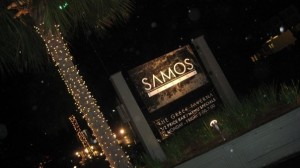 In 2009, Samos Taverna appeared on the scene. Offering a Mediterranean and Greek-style tapas menu, the restaurant’s cuisine was described as that of the Greek island of Samos, complete with Greek wines. Samos shuttered after about two years.
In 2009, Samos Taverna appeared on the scene. Offering a Mediterranean and Greek-style tapas menu, the restaurant’s cuisine was described as that of the Greek island of Samos, complete with Greek wines. Samos shuttered after about two years.
Next at 819 Colemand Boulevard came Next Door Bistro. Opening in August of 2011, Next Door was the project of executive chef and owner Ben Berryhill, who has Red Drum down the street. The Bistro was part pizza place, part Italian restaurant, and part French bistro. And just as fast as it appeared, Next Door Bistro disappeared, closing after a final night of service on October 5, 2012.
The Americano is not part Italian, not part French, nor was it a bistro or tavern. Perhaps this new concept that calls upon the nostalgia of the 40s will break the streak of turnover at this address. See the latest on The Americano here.
We hope the best to anyone who shares our love for classic convertibles!
Flashback Fridays: The Woodlands, with Chef Ken Vedrinski 10.3.14
“Woodlands means excellence. Period.” The title of Jane Kronsberg’s 1995 review of The Woodlands Resort & Inn codified the entirety of the dining experience—the food, the ambience, and the service. The Woodlands, located in Summerville, SC, was fine dining at its best. It was recognized as such by a multitude of awards that came in years following this review, including the only Mobile Five-Stars awarded in the state, and the only perfect score for food by Conde Nast Travel in 2002.
At the helm was Chef Ken Vedrinski, who, Kronsberg wrote, “is a master of his craft.” Coming from the acclaimed SwissÔtel Atlanta, Vedrinski brought principles of flawless execution kept lively with creativity and introduction of local, seasonal ingredients and an early adoption of the farm-to-table philosophy, a practice that earned him a place on The Today Show.
After a wildly successful start to his culinary career in the Lowcountry, Vedrinski left The Woodlands to build a restaurant of his own. He opened Sienna in Daniel Island, SC, and thus began his career as a restaurant owner and chef of Italian cuisine.
Recently, we checked in with Chef Vedrinski to talk about the development of his career, his Italian influences, and to get his take on the restaurant industry in Charleston.
The review of The Woodlands was written in 1995, how has the restaurant industry changed since then?
Ken Vedrinski (KV): Charleston wasn’t known as a culinary town. Back when I was at The Woodlands, there were only a few fine dining restaurants, Restaurant Million being one. Frank Lee and a few others were making marks downtown, but Charleston’s well-known chefs of today had not come to town, some weren’t even born yet.
Back then, most restaurants were still pretty basic; we questioned whether Charleston was ready to move beyond shrimp and grits and Frogmore stew. We found success with a modest number of local foodies supported by a steady stream of travelers from outside the region. The Woodlands was the first in the area to receive national accolades, and I believe it was part of what put Charleston on the map, along with the work of Marlene and Louis Osteen and the Salute to Southern Chefs. That’s when things began to change for the city.
The result of this work, and perhaps the most profound change for Charleston, Vedrinski said, has been the recent exponential increase in restaurants. He commented that the influx of new places is adding pressure to kitchen staff and front-of-house staff, as well. The lack of service and back-of-house staff has been reported on already, but Vedrinski went as far as to warn of a potential decline if businesses cannot find enough high quality, professional cooks to support their chefs, or adequately trained waitstaff to attend to their diners. “What we don’t want is to look back years from now and see a restaurant graveyard,” Vedrinski stated.
Vedrinski left The Woodlands to open Sienna, his first Italian-only venture, where he wore the chef’s hat along with the weighty responsibilities of a first-time owner.
KV: I learned how to be a restaurateur by going through it—chefs and owners are two very different things. Chefs don’t need to know anything about HR, insurance, and the like. Chef-owners need to be business savvy and understand every single vendor they work with, or they pay the price. As a chef, I never really knew where the money went, but when I opened Sienna, I quickly learned where it was being spent, and especially became aware when it wasn’t there.
Recalling hard lessons, Vedrinski shared the first time he had to pass on purchasing a special, high-priced ingredient because the money was not available, and sorrowfully recalled the moment when he could not make payroll on time. “Chefs have to learn by going through the ordeal of seeing what everything costs. Now, you’re no longer just cooking, you need to be well-rounded and understand every aspect of the business,” he said. Vedrinski lamented, “The world is full of great chefs who’ve lost great restaurants.”
After handing over the reins at Sienna, Vedrinski looked to the Charleston peninsula for a second course of Italian cuisine. In 2008, he opened Trattoria Lucca as the sole owner, chef, and sommelier. Noticing the rareness of a chef who is also a sommelier, we asked Vedrinski what his understanding of wine brings to his cooking.
KV: Italian cuisine has great synergy between food and wine – wine is a huge part of the Italian food scene, and the pairings are important. You can sit down with someone else, a hired sommelier, but it can sometimes feel like you’re speaking Chinese when talking about the ingredients and the flavors of your food. Besides, who knows the chef’s food better than the chef? Being a sommelier makes choosing and pairing the wines so much better.
I also love to drink Italian wine and took a huge interest in it. During trips to Italy, I went to the winemakers and saw what they were doing. I know the makers of about half the wines on our list and have been to their vineyards. This helps me understand the nuances of flavors, where they come from, and how they will work with my dishes. I can also help our guests choose a wine while telling them the story of the winemakers and their vineyards—and I think this adds tremendously to the experience at Lucca.
Vedrinski opened Lucca contented with the idea that it would be his focus for the foreseeable future; however, the opportunity arose for a new location well beyond the peninsula, one that he saw as a challenge in authenticity. He opened Coda del Pesce in 2013 on the Isle of Palms, a small beach community outside the city that typically catered to tourists.
Cultivated from his Italian heritage and travels to Italy, Vedrinski’s understanding of true and authentic Italian cuisine is rooted in the traditional ways of the people in the region—the cuisine is curated by the trades of the Italian people and their use of the land and its resources. He was adamant about maintaining this level of fidelity in what he served, regardless of the address.
KV: Italian food is peasant food, a humble and simple cuisine, and each town or region has its own style. They use uncomplicated ingredients from the farmers and artisans nearby, a practice that was once done here with the use of rice and other grains in traditional Gullah cuisine. I see the return of this in Charleston—farming, craftsmanship, and artisanal products coming back—as a very good thing for the culinary industry. But we’re not there yet. Italian in America is mostly “Americanized,” with overly ground meats, cheap ingredients, and the use of too much cheese. Even on the beach, I was not going to do this. I’d go broke before cooking like that.
As the sole proprietor of Coda del Pesce, Vedrinski is unencumbered by the influence of an owner or investor and is not driven by the bottom line—a freedom that allowed him to take a chance putting an Italian restaurant in a southern beach town. He is determined to share with Charleston and its many visitors the pleasantness of genuine Italian fare, whether through the use of Italian ingredients, Italian wine, or by showcasing the Italian application of being content preparing simple ingredients found around you. “There is a little luck involved, but if it tastes good and there’s value in it, people will come.”
During our talk, Chef Vedrinski humbly abridged more than two decades of restaurant experience through his eyes as a chef, owner, and sommelier. We hope to continue learning and sharing teachings from Ken and other industry veterans as the culinary environment grows and evolves.
FlashBack Fridays: The Goodie House 9.12.14
The Goodie House Review
January 22, 1998
Finding the Post and Courier restaurant review for the Goodie House unearthed memories of small cafes and shiny diners with round leather barstools, familiar faces, and other nostalgia from back when Charleston’s culinary scene was more like a quiet front porch than a global performance stage.
The original Goodie House many will recall was in a humble cottage-like structure on Calhoun Street. Now a Starbucks, the building sees throngs of visitors and College of Charleston students every day. While the exterior of the building has remained the same, much around it has been built up, sighting the college’s new multi-level science and arts buildings, and the recent tagging by artist Shepard Fairey of the dormitory across the street.
But before all of that, the Goodie House served comfort food to regulars, some of whom stopped in on a daily basis. Despite the modesty of the Goodie House, the chili, burgers, and especially the pies were “legendary,” to quote Jane Kronsberg, who reviewed the reincarnation of the Goodie House in 1998 at its Ashley River Road location.
During her late dinner (they arrive 45 minutes prior to closing time), Kronsberg summoned the famous burger and the pie. The wait staff was forthcoming that the hamburger had been cooked earlier in the day and warmed up for the late night service. As one would imagine, it was not stellar. And the pie? It was nowhere to be found, as they do not make pies at the end of the day because they don’t keep well overnight.
In today’s world of critic reviews, 24-hour and instant social media postings, restaurants can easily be pressured into performing well beyond their means or original intentions to please a handful of occasional patrons. The performance by the Goodie House on the night of Kronsberg’s review might seem by today’s standards detrimental or even incendiary; however, might it simply be that the Goodie House wanted to be authentically portrayed—no matter who was sitting at the counter?
Near the end of the write up, Kronsberg noted, “All in all, things were just as I had expected.” And isn’t that the charm and draw of diners and neighborhood cafés? They remain the same, they stay true to their original recipes, no matter what chatter or changes are taking place around them.
We hope our readers will find a moment to enjoy a neighborhood café or old fashion diner for what it is and ask nothing more. Or better yet, become a regular somewhere and experience the joy of seeing familiar faces behind the counter each time you go.
FlashBack Fridays: Through the Years at 14 North Market Street 8.22.14
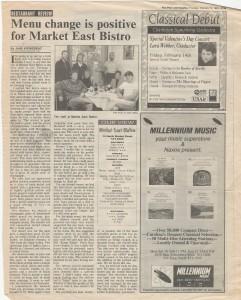 Charleston is a burgeoning town with a food industry to match. The city experiences a steady inhale and exhale of residents and visitors alike pining to partake in this culinary metropolis and driving the need for diverse options to quell their hunger.
Charleston is a burgeoning town with a food industry to match. The city experiences a steady inhale and exhale of residents and visitors alike pining to partake in this culinary metropolis and driving the need for diverse options to quell their hunger.
With this sentiment in mind, we searched through the old restaurant reviews from The Post and Courier. Among them we found the write up for Market East Bistro and were curious to uncover what types of establishments have occupied this location–14 North Market Street–over the years.
The review of Market East Bistro written by Jane Kronsberg ran on Thursday, February 13, 1997. This was Konsberg’s second review of the bistro since its opening, and she wrote fondly of her experience once again. The lunch and dinner selections highlighted the many seafood options available at this accessible but refined bistro. As one patron was quoted in the review, the food and service were good and the prices “extremely reasonable.”
After the closure of Market East Bistro, Vintage Restaurant and Wine Bar took over the spot. Owned by Kevin Kelley, who was also the wine director, the restaurant boasted hundreds of bottles to pair with Executive Chef Thomas Clayton’s Provencal-style cuisine. Contrary to many establishments in the neighborhood, Vintage did not showcase typical Lowcountry dishes, rather offering diners a taste of France.
Cordavi then took up residence at 14 N. Market. Turning the dial to fine dining, Cordavi became known as one of Charleston’s top restaurants in its opening year, earning Esquire magazine’s nod for Top 20 New Restaurants in 2006. The establishment was written about as a leader in sophisticated haute cuisine with the potential to launch Charleston onto the culinary scene with longtime cosmopolitan players. Described as a maverick in the local dining scene, Cordavi showcased cutting edge culinary arts and was unapologetically “un-Southern,” regularly calling international ingredients to the table. Perhaps with the same surprise invoked by its creative approach, Cordavi closed leaving many lamenting a too-short stay. Read more about Cordavi in the City Paper review by writer Jeff Allen.
Another 14 N. Market Street establishment was Gilligan’s Seafood Restaurant. Gilligan’s, a family-friendly casual spot, brought a fun and lively atmosphere to the historical market and served as great place for traveling groups to dine. The bar at Gilligan’s stayed open well into the night, hosting late-night revelers in search of an affordable good time.
And finally, Burwell’s Stone Fire Grill is the current resident of 14 N. Market Street. An expansive establishment, the owners exposed the hidden history of the space by removing drywall to reveal 1800s-era cypress walls, paying homage to Market Street’s rich past. Bringing a modern twist to the traditional steakhouse, Burwell’s uses a 1,400 degree wood-fire grill and is promising an experience divergent from the overly masculine characteristics common of steakhouses. Read more about Burwell’s in this write up in the City Paper.
Looking back on the many restaurants that once called 14 N. Market Street home, we see a wide spectrum of culinary approaches. And with the diversity of palates in Charleston, coming from world travelers, vacationing families, long-time locals, and new residents, we are sure there is a place for just as many restaurant styles, themes, and cuisines and look forward to what the future might bring.
FlashBack Fridays: Then and Now at 2063 Middle Street 7.18.14
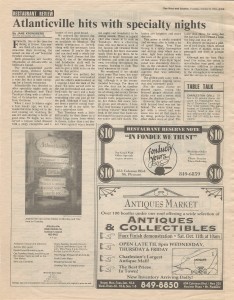 Atlanticville, located at 2063 Middle Street, was a Sullivan’s Island institution for 22 years. Now only a memory, we wanted to revisit the reputation of the restaurant and explore its lasting impact on the Sullivan’s Island culinary scene by digging up its review and reaching out to the new residents of 2063 Middle Street.
Atlanticville, located at 2063 Middle Street, was a Sullivan’s Island institution for 22 years. Now only a memory, we wanted to revisit the reputation of the restaurant and explore its lasting impact on the Sullivan’s Island culinary scene by digging up its review and reaching out to the new residents of 2063 Middle Street.
The Post and Courier’s Food Critic Jane Kronsberg reviewed the restaurant on October 9, 1997. Highlighting the establishment’s view and comfortable porch seating, Kronsberg noted the pleasantries of outdoor dining in Charleston during the fall. Atlanticville set itself apart from its island neighbors by steering away from the typical overly casual beach atmosphere and unsophisticated menu. Upon opening, the late Chef Phil Corr was at the helm. He took a risk gambling on the notion that beachgoers would find respite from sun and sand inside his relatively upscale accommodations and be drawn to his integration of locally sourced ingredients.
It was a wager that worked. A sister publication of USA Today, The 10Best wrote, “Exceptional cuisine is the hallmark of this relaxed Sullivan’s Island restaurant, and awards rain constantly upon its chef and kitchen.” General Manager Andrew Harris stepped in for the last part of Atlanticville’s two-decade reign and continued to honor Corr’s culinary passion.
In 2012 the restaurant closed for what was to be a period of renovation; however, it never reopened and shuttered for good later that summer. While Atlanticville may be closed for ever, it raised the bar on island cuisine, laying a foundation for further refinement of this culinary genre.
Not long after its closure, whispers of what would replace Atlanticville began to circulate within the industry, growing louder when the owner of Wild Olive Restaurant Group sought permitting for Sullivan’s Island. Soon enough, it was announced that Chef Jacques Larson and the Wild Olive Restaurant Group would open a new venture at 2063 Middle Street.
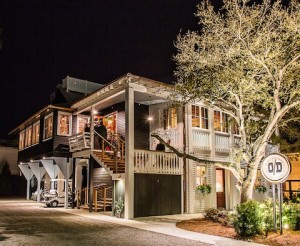 On March 19, 2014, The Obstinate Daughter opened for business. According to the restaurant’s website, the name comes from Revolutionary War history on Sullivan’s Island. In 1776, defenders of Fort Sullivan saved the island from British capture during the Battle of Sullivan’s Island. It was this act that “inspired a London political cartoon of the defiant defenders of Charleston: “Miss Carolina Sulivan, one of the obstinate daughters of America, 1776”.”
On March 19, 2014, The Obstinate Daughter opened for business. According to the restaurant’s website, the name comes from Revolutionary War history on Sullivan’s Island. In 1776, defenders of Fort Sullivan saved the island from British capture during the Battle of Sullivan’s Island. It was this act that “inspired a London political cartoon of the defiant defenders of Charleston: “Miss Carolina Sulivan, one of the obstinate daughters of America, 1776”.”
Calling itself a “Food Fort,” the restaurant boasts Southern cuisine with French, Italian, and Spanish influences. It is progressive in its offerings and business approach, seeking a Green Restaurant Certification. The Obstinate Daughter has decidedly upped the ante on island dining. And we’re not the only ones who think so. Writer Robert Moss in a write up for the Charleston City Paper noted the establishment has “the right formula to round out a revitalized beach dining scene.”
While Charleston and its surrounding islands are certainly in the midst of a culinary awakening, this current movement was surely sparked by the restaurants and chefs of yesteryear. One cannot deny that Atlanticville’s gamble may have incited the desire for more urbane fare on this barrier island.
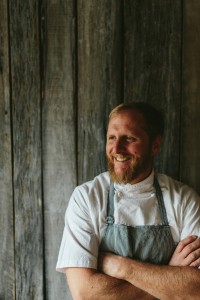 When asking Chef Larson about his influences for the new restaurant, we wondered if Atlanticville may have played a part.
When asking Chef Larson about his influences for the new restaurant, we wondered if Atlanticville may have played a part.
Larson: Having moved to Charleston in 1996, I was quite familiar with Atlanticville restaurant and more specifically, Phil Corr. Phil was a “chef’s chef.” His hard work ethic and passion for food mixed with a great sense of humor made him a local favorite. He was also an early advocate of sourcing things locally. After the sad loss of Phil to lung cancer, Andrew Harris took the torch at Atlanticville, and I would most certainly say that he embodied the same drive for hospitality excellence that Phil strove to achieve.
These factors have had a direct influence on what we set out to accomplish on Sullivan’s Island. Focusing on using local products, building genuine relationships with guests and delivering high quality food and service in a comfortable, yet polished setting. [This] is still the same goal at 2063 Middle St.
The Obstinate Daughter’s Revolutionary War-inspired motif reflects its revolutionary ideologies about beach cuisine. We hope this “Food Fort” defends its stay on Sullivan’s Island—much like its stubborn influencer, Miss Carolina Sulivan— for years to come, and that it continues to carry on so beautifully the hospitality and passion of the chefs and staff who came before.
FlashBack Fridays: Center Street and East Arctic Avenue, Folly Beach 7.4.14
FlashBack Fridays: Center Street and East Arctic Avenue, Folly Beach
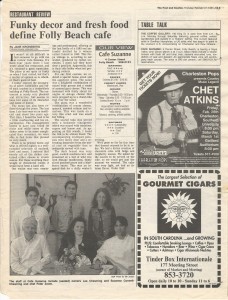 It’s the 4th of July, and in the Lowcountry, that means almost everyone is headed to the beach. In honor of the holiday, we sifted through our collection of reviews to find a beachside eatery that surely would have been abuzz with patrons celebrating America’s independence.
It’s the 4th of July, and in the Lowcountry, that means almost everyone is headed to the beach. In honor of the holiday, we sifted through our collection of reviews to find a beachside eatery that surely would have been abuzz with patrons celebrating America’s independence.
Folly Beach, known as the Edge of America, has seen more than its fair share of restaurants and bars through the years. Like Folly’s swirl of locals, day-trippers, and transient residents, restaurants here are eclectic and seem to ebb and flow with the tide. On one particular corner of the island’s main district, the corner of Center Street and East Arctic, sat Café Suzanne.
Jane Kronsberg first reviewed Café Suzanne in 1994, and revisited for a second taste in 1997. She described the restaurant as having a good reputation and funky flare fit for Folly Beach. When looking into the restaurant’s location, we dreamily wondered what may have come before Café Suzanne. We discovered a history of offbeat inhabitants reflective of the beach town’s shifting shoreline and culture of frivolity.
In the 1920s, The Folly Pier and Pavilion occupied the spot where Center Street and East Arctic converge. This was back when Arctic Street looked akin to Coney Island, boasting its own Ferris wheel, among other amusements. The Pavilion was later transformed into the Dancing Bear, Folly Beach’s own bowling alley, and later into a bar named Monk’s Corner.
More recently, The Terrapin Café took up residency here. Writer Jeff Allen reviewed the spot 11 years after Kronsberg’s visit to Café Suzanne. Allen was not keen on the cuisine, but acquiesced that the island’s constant parade of motley beach-goers might find their place at the table here (or on its dark dance floor post sunset).
Perhaps caught in the outgoing tide of tourists, trekkers, and beach bums, The Terrapin Café eventually shuttered to make way for another hopeful restaurateur. Rita’s Seaside Grille now sits proudly at the corner of Center and East Arctic, and, as the décor demands, is reminiscent of the days long before The Terrapin, Café Suzanne, and the Dancing Bear. Rita’s invokes memories of the boardwalk carnival era when the Pavilion was the main attraction and everyone was dancing to the sounds of The Beach Boys. Allen also reviewed Rita’s, and in his 2009 write-up suggested that the establishment might kindle a shift in food culture on the island. Five years have since passed, and while Folly Beach—true to its nature—has been slow to change, Rita’s has kept a stronghold on this corner.
We are certain on this 4th of July that Folly Beach and its many restaurants will be brimming with the same eclectic patrons it has always welcomed, and we look forward to seeing what washes up next for this quaint and curious beach community.
FlashBack Fridays: Saracen’s Reviews 6.27.14
Saracen Reviews: April 22, 1992; September 22, 1994; and November 12, 1998
Saracen was well known for its lush interior, described on several occasions as a “feast for the eyes.” Located at 141 East Bay Street in Charleston, SC, the restaurant occupied the Farmer’s and Exchange Bank building, a structure equally known for its appearance and brush with fate.
Before Owner and Chef Charlie Farrell opened Saracen in 1990, the building served as office space for Sen. Fritz Hollings and was nearly demolished to make way for parking. Saved in 1970, the building was restored and added to the list of National Historic Landmarks in 1973.
The building’s architecture, Moorish and Spanish in style, is rare in the Holy City; this uniqueness nicely complemented the unexpected cuisine one would find inside.
Former Post and Courier restaurant critic Jane Kronsberg reviewed Saracen on three occasions, in 1992, ’94, and ’98, detailing a pleasant experience each time. The cuisine featured Mediterranean and Asian ingredients and was described as new American with Middle Eastern flavor. Like many restaurants of today, the menu at Saracen was small and changed regularly utilizing seasonal produce.
Highlights of the menu included dishes like “salmon three ways,” chilled beet and grapefruit soup, Thai fish cakes, shrimp and pork egg rolls, apple and potato crusted trout cake, and coffee-rubbed quail. Saracen presented unique dishes including Cioppino, an Italian-American fish stew, and quenelles, creamed fish or meat combined with bread crumbs and light egg binding, a dish not often served in American establishments.
Chef Farrell also infused Moroccan, Vietnamese, and Caribbean spices into his dishes creating a menu of eclectic offerings over the years.
The establishment’s second floor was home to Charlie’s Little Bar (named for Farrell) and echoed the Moorish architecture, luxury, and comfort of the first-floor dining area. Kronsberg reported that the Little Bar attracted big crowds out for late weekend nights.
The décor at Saracen, Kronsberg noted, provided a romantic atmosphere reminiscent of the mystery and magic conjured by stories of Arabian Nights. She described the restaurant as luxurious, glamorous, and “one of the best-looking restaurants around.” One last note, Kronsberg ranked Saracen’s decibel level at “quiet,” and in light of a recent Post and Courier report on restaurant noise, such a tranquil dining experience might be—like the Saracen—a thing of the past.
The building that housed Saracen for many years now stands vacant, hosting special events from time to time. We hope that a place this special and with so much history will once again come to life as some sort of amazing culinary gem for the city.

CATEGORIES
PRESS INQUIRIES
Angel Postell
Home Team Public Relations
(843) 557-4077
angel@hometeampr.com
